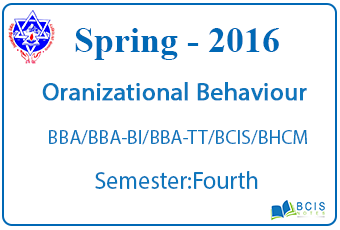
Fundamentals of Organizational Behaviour – Spring, 2016
This is the question set along with answers to Fundamentals of Organizational Behaviour Spring 2016, which was taken by the Pokhara University.
Pokhara University – Fundamentals of Organizational Behaviour Spring 2016
| Level: Bachelor | Semester –Spring | Year: 2016 |
| Program:BBA/BBA-BI/BBA-TT/BCIS/BHCM | Full Marks: 100 | |
| Course: Fundamentals of Organizational Behaviour | Pass Marks: 45 | |
| Time: 3hrs. | ||
Section “A”
Very Short Answer Questions
Attempt all the questions.
1. What are the key elements of OB?
2. What is a cross-functional work team?
3. Show the differences between personality and behavior.
4. What do you mean by learning?
5. Name any two hygiene and motivating factors as per the two factors theory of motivation.
6. Name the dimensions of leader’s behavior identified by Ohio State Studies and Michigan study.
7. List out the pattern of conflict.
8. What are the 5 ways to overcome resistance to change?
9. Define groups and the types of groups?
10. What do you mean by team efficacy?
Section “B”
Descriptive Answer Questions
Attempt any six questions.
11. Give the concept of organizational behavior. Explain the major behavioral challenges that Nepalese managers face in their organization.
12. What is personality? How do we typically measure it? What factors determine personality?
13. Distinguish between classical conditioning and operant conditioning and write down the application of operant conditioning in an organization?
14. Define the path-goal theory of leadership. Explain the current issues in leadership.
15. Is conflict necessary in an organization? Write about the interactionist view of conflict?
16. Communication plays a vital role in an organization? Explain the barriers to effective communication.
17. What do you understand by organizational development and what are its techniques?
Section “C”
Case Analysis
18. Read the scenario and answer the question that follows.
Tony Stark had just finished his first week at Reece Enterprises and decided to drive upstate to a small lakefront lodge for some fishing and relaxation. Tony had worked for the previous ten years for the O’Grady Company, but O’Grady had been through some hard times of late and had recently shut down several of its operating groups, including Tony’s, to cut costs. Fortunately, Tony’s experience and recommendations had made finding another position fairly easy. As he drove the interstate, he reflected on the past ten years and the apparent situation at Reece.
At O’Grady, things had been great. Tony had been part of the team from day one. The job had met his personal goals and expectations perfectly, and Tony believed he had grown greatly as a person. His work was appreciated and recognized; he had received three promotions and many more pay increases.
Tony had also liked the company itself. The firm was decentralized, allowing its managers’ considerable autonomy and freedom. The corporate Culture was easygoing. Communication was open. It seemed that everyone knew what was going on at all times, and if you didn’t know about something, it was easy to find out.
The people had been another plus. Tony and three other managers went to lunch often and played golf every Saturday. They got along well both personally and professionally and truly worked together as a team. Their boss had been very supportive, giving them the help they needed but also staying out of the way and letting them work.
When word about the shutdown came down, Tony was devastated. He was sure that nothing could replace O’Grady. After the final closing was announced, he spent only a few weeks looking around before he found a comparable position at Reece Enterprises.
As Tony drove, he reflected that “comparable” probably was the wrong word. Indeed, Reece and O’Grady were about as different as you could get. Top managers at Reece apparently didn’t worry too much about who did a good job and who didn’t. They seemed to promote and reward people based on how long they had been there and how well they played the never-ending political games.
Maybe this stemmed from the organization itself, Tony pondered. Reece was a bigger organization than O’Grady and was structured much more bureaucratically. It seemed that no one was allowed to make any sort of decision without getting three signatures from higher up. Those signatures, though, were hard to get. All the top managers usually were too busy to see anyone, and interoffice memos apparently had very low priority.
Tony also had had some problems fitting in. His peers treated him with polite indifference. He sensed that a couple of them resented that he, an outsider, had been brought right in at their level after they had had to work themselves up the ladder. On Tuesday he had asked two colleagues about playing golf. They had politely declined, saying that they did not play often. But later in the week, he had overheard them making arrangements to play that very Saturday.
It was at that point that Tony had decided to go fishing. As he steered his car off the interstate to get gas, he wondered if perhaps he had made a mistake in accepting the Reece offer without finding out more about what he was getting into.
Case Questions
a) Identify several concepts and characteristics from the field of organizational behavior that this case illustrates.
b) What advice can you give Tony? How would this advice be supported or tempered by behavioral concepts and processes?
c) Is it possible to find an “ideal” place to work? Explain.
If you liked our content Fundamentals of Organizational Behaviour || Spring, 2016 then, you May Also Like Internet Technology || Spring,2016 || Pokhara University || BCIS

Leave a Reply